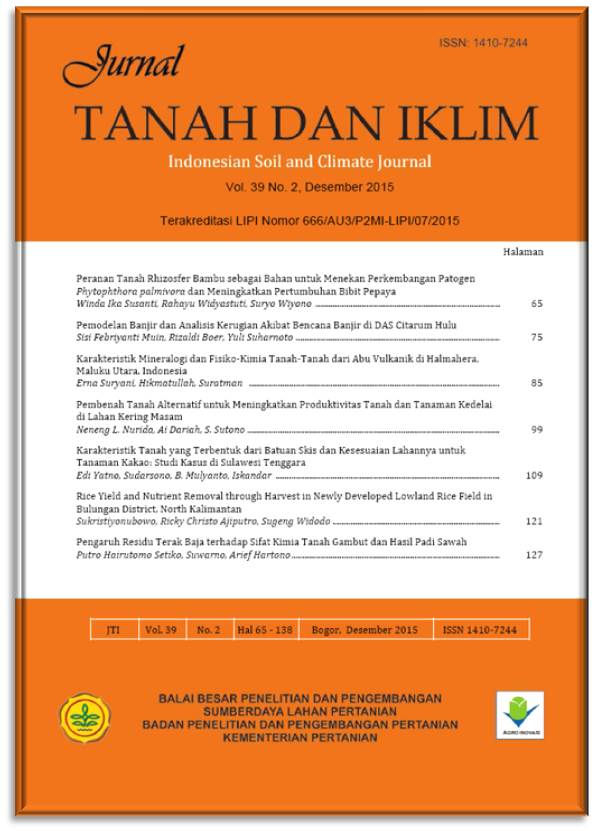Pengaruh Residu Terak Baja terhadap Sifat Kimia Tanah Gambut dan Hasil Padi Sawah
Abstract
Abstrak. Terak baja mengandung silikon, kalsium, dan magnesium dalam jumlah yang besar, sehingga bermanfaat sebagai alternatif bahan pembenah tanah dan sumber unsur hara bagi tanaman padi sawah di tanah gambut. Percobaan pot untuk mengevaluasi pengaruh terak baja terhadap perbaikan sifat kimia tanah gambut dan pertumbuhan padi sawah (IR 64) telah dilakukan selama dua musim tanam pada Februari-Agustus 2012 dan Maret-September 2013. Tujuan dari penelitian ini adalah untuk mengetahui respon padi sawah terhadap residu electric furnace slag (EF slag) dan blast furnace slag (BF slag) pada pertanaman ketiga. Perlakuan yang diaplikasikan pada tanaman pertama terdiri dari EF slag dan BF slag dengan dosis 0, 2, 4, 6, dan 8% dari bobot kering oven tanah. Penelitian telah dilakukan pada Februari-Agustus 2014. Hasil penelitian menunjukkan bahwa residu EF slag mampu memperbaiki Ca dan Mg dapat ditukar, dan ketersediaan Fe dan Mn dalam tanah. Sementara residu BF slag hanya dapat memperbaiki ketersediaan SiO2 dan Zn dalam tanah. Hal ini mengakibatkan tinggi tanaman padi, jumlah anakan maksimum, anakan produktif, dan hasil padi pada residu EF slag juga relatif lebih tinggi bila dibandingkan dengan residu BF slag. Hasil padi tertinggi pada residu EF slag mencapai 42 g pot-1, sedangkan pada residu BF slag hanya mencapai 4,2 g pot-1. Oleh karena itu, EF slag direkomendasikan untuk memperbaiki sifat kimia tanah gambut. Efektifitasnya bertahan minimal hingga musim ketiga tanaman padi sawah.
ÂÂÂÂ
Abstract. Steel slag contains a high amount of silicon, calcium, and magnesium, that are useful as an alternative ameliorant and nutrient source for paddy rice in peat soil. Pot experiment to evaluate the effects of steel slag to improve the chemical properties of peat soil and the growth of paddy rice (IR 64) was carried out during two seasons in February - August 2012 and March-September 2013. The aim of this research was to study the response of paddy rice to the electric furnace slag (EF slag) and blast furnace slag (BF slag) residue in the third growing season. The treatments were applied on the first season consisted of EF slag and BF slag with dosage of 0, 2, 4, 6, and 8% by weight, of the dry soil. The experiment was carried out in February-August 2014. The results showed that the EF slag residue was able to improve the exchangeable Ca and Mg, and available Fe and Mn in soil. While BF slag residue can only improve the availability of SiO2 and Zn. This caused the height of rice plant, number of maximum tillers, productive tillers, and rice yield by EF slag residue also relatively higher than that of BF slag residue. The highest rice yield by EF slag residue reached 42 g pot-1, while by BF slag residue only reached 4.2 g pot-1. Therefore, we recommend the use of EF slag for improving chemical properties of peat soil. Its effectiveness is still significant at least until the third season of paddy rice since the application.


